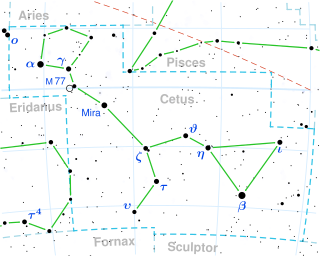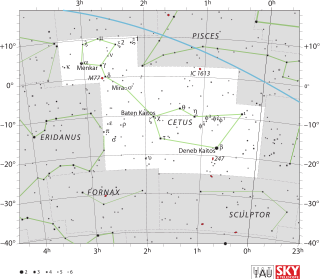
Alpha Ceti, officially named Menkar, is the second-brightest star in the constellation of Cetus. It is a cool luminous red giant estimated to be about 250 light years away based on parallax.

Pi Virginis is a binary star in the zodiac constellation of Virgo. It is visible to the naked eye with an apparent visual magnitude of 4.64. The distance to this star, based upon parallax measurements, is roughly 380 light years.

Pi Andromedae is the Bayer designation for a binary star system in the northern constellation of Andromeda. With an apparent visual magnitude of 4.4, it is visible to the naked eye. It is located approximately 580 light-years from Earth.

Pi Arietis, Latinized from π Arietis, is the Bayer designation for a multiple star system in the northern constellation of Aries. Based upon parallax measurements made during the Hipparcos mission, this system is approximately 800 light-years distant from Earth and has an apparent visual magnitude of 5.21. This is bright enough to be faintly seen with the naked eye.

Zeta Ceti is a binary star in the equatorial constellation of Cetus. It has a combined apparent visual magnitude of 3.74, which is bright enough to be seen with the naked eye. Based upon parallax measurements taken during the Hipparcos mission, it is approximately 235 light-years from the Sun.
Pi1 Cygni (π1 Cygni, abbreviated Pi1 Cyg, π1 Cyg) is a binary star in the northern constellation of Cygnus. It is visible to the naked eye, having a combined apparent visual magnitude of 4.66. The distance to this system can be roughly gauged by its annual parallax shift of 1.89 mas, which yields a separation of around 1,700 light years from the Sun, give or take a hundred light years.

Eta Ceti is a star in the equatorial constellation of Cetus. It has the traditional name Deneb Algenubi or Algenudi. The apparent visual magnitude of this star is +3.4, making it the fourth-brightest star in this otherwise relatively faint constellation. The distance to this star can be measured directly using the parallax technique, yielding a value of 123.9 light-years.

Delta Ceti, Latinized from δ Ceti, is a single, blue-white hued star in the equatorial constellation of Cetus. The star's apparent visual magnitude of +4.06 means it is near to the cusp of the faintest third of the stars that are visible the ideally-placed naked eye. It is 0.3238° north of the celestial equator compared to the celestial north pole's 90°. The star is positioned about 0.74° WNW of the spiral galaxy M77, but which at apparent magnitude 9.6 needs magnification to be made out and has an apparent size of only 0.1° by 0.12°.
Theta Ceti, Latinized from θ Ceti, is a solitary, orange-hued star in the equatorial constellation of Cetus. It is visible to the naked eye with an apparent visual magnitude of 3.60. Based upon an annual parallax shift of 28.66 mas as seen from Earth, it is located about 114 light-years from the Sun. At that distance, the visual magnitude is diminished by an extinction factor of 0.10 due to interstellar dust.
Pi2 Cygni, Latinized from π2 Cygni, is a triple star system in the northern constellation of Cygnus. It is visible to the naked eye about 2.5° east-northeast of the open cluster M39, having an apparent visual magnitude of 4.24. Based upon an annual parallax shift of 2.95 mas, it is located at a distance of roughly 1,100 light years from the Sun.

Epsilon Herculis, Latinized from ε Herculis, is a fourth-magnitude multiple star system in the northern constellation of Hercules. The combined apparent visual magnitude of 3.9111 is bright enough to make this system visible to the naked eye. Based upon an annual parallax shift of 21.04 mas as seen from Earth, it is located 155 light years from the Sun. The system is moving closer to the Sun with a radial velocity of −25 km/s.

Lambda Ceti, Latinized from λ Ceti, is B-type star of fifth-magnitude located in the constellation Cetus. Historically, the star bore the traditional name Menkar, although today that name is more commonly associated with α Ceti.

Xi Piscium (ξ Piscium) is an orange-hued binary star system in the zodiac constellation of Pisces. In 1690, the astronomer Johannes Hevelius in his Firmamentum Sobiescianum regarded the constellation Pisces as being composed of four subdivisions. Xi Piscium was considered to be part of the Linum Austrinum, the South Cord. The star is visible to the naked eye, having an apparent visual magnitude of 4.60. Based upon an annual parallax shift of 11.67 mas as seen from Earth, it is located about 280 light years from the Sun. It is moving away from the Sun, having a radial velocity of +26 km/s.
Epsilon Ceti, Latinized from ε Ceti, is the Bayer designation for a binary star system located in the equatorial constellation of Cetus. It is faintly visible to the naked eye with an apparent visual magnitude of +4.84. Based upon an annual parallax shift of 14.58 mas, it is located around 98 light-years away from the Sun.

ν Ceti, Latinized as Nu Ceti, is a binary star system in the equatorial constellation of Cetus. It is visible to the naked eye as a faint point of light with a combined apparent visual magnitude of 4.86. The system is located approximately 340 light years distant from the Sun, based on parallax, and is drifting further away with a radial velocity of 4.8 km/s. Nu Ceti is believed to be part of the Ursa Major stream of co-moving stars.

Xi1 Ceti , Latinized from ξ1 Ceti, is a binary star system located in the equatorial constellation of Cetus. It is visible to the naked eye with a combined apparent visual magnitude of +4.36. The distance to this system is approximately 340 light years based on parallax measurements, and it is drifting closer to the Sun with a radial velocity of −4 km/s. The proximity of the star to the ecliptic means it is subject to lunar occultations.
Rho Ceti , Latinized from ρ Ceti, is the Bayer designation for a star in the equatorial constellation of Cetus. It is faintly visible to the naked eye with an apparent visual magnitude of 4.885. The distance to this star, based upon an annual parallax shift of 7.15 mas, is around 460 light years.
Sigma Ceti is the Bayer designation for a star in the equatorial constellation of Cetus. With an apparent visual magnitude of 4.78, it can be seen with the naked eye on a dark night. Based upon an annual parallax shift of 37.46 mas, it lies at an estimated distance of 87.1 light years from the Sun. It is a probable astrometric binary star system.

Eta Hydrae is a star in the equatorial constellation of Hydra. With an apparent visual magnitude of 4.3, it is visible to the naked eye. However, it is the faintest of the five stars that form the "head" of the hydra. Based upon an annual parallax shift of 5.56 mas, it is located roughly 590 light years from the Sun.

Pi5 Orionis (π5 Ori, π5 Orionis) is a binary star system in the constellation Orion. It has an apparent visual magnitude of 3.69, which is bright enough to be visible to the naked eye on a clear night. Based upon an annual parallax shift of 2.43 mas, it is around 1,300 light-years distant from the Sun.









